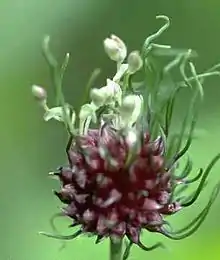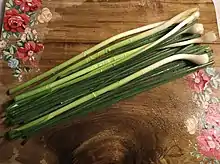Allium vineale
Allium vineale (wild garlic, onion grass, crow garlic or stag's garlic) is a perennial, bulb-forming species of wild onion, native to Europe, northwestern Africa and the Middle East.[2] The species was introduced in Australia and North America, where it has become a noxious weed.[3][4][5][6][7]
| Crow garlic | |
|---|---|
 | |
| Umbel showing bulbils and a few flowers | |
| Scientific classification | |
| Kingdom: | Plantae |
| Clade: | Tracheophytes |
| Clade: | Angiosperms |
| Clade: | Monocots |
| Order: | Asparagales |
| Family: | Amaryllidaceae |
| Subfamily: | Allioideae |
| Genus: | Allium |
| Species: | A. vineale |
| Binomial name | |
| Allium vineale | |
| Synonyms[1] | |
|
Synonymy
| |
Description
All parts of the plant have a strong garlic odour. The underground bulb is 1–2 cm diameter, with a fibrous outer layer. The main stem grows to 30–120 cm tall, bearing 2–4 leaves and an apical inflorescence 2–5 cm diameter comprising a number of small bulbils and none to a few flowers, subtended by a basal bract. The leaves are slender hollow tubes, 15–60 cm long and 2–4 mm thick, waxy texture, with a groove along the side of the leaf facing the stem. The inflorescence is a tight umbel surrounded by a membranous bract in bud which withers when the flowers open. Each individual flower is stalked and has a pinkish-green perianth 2.5 to 4.5 mm (3⁄32 to 3⁄16 in) long. There are six tepals, six stamens and a pistil formed from three fused carpels. Mixed with the flowers are several yellowish-brown bulbils. The fruit is a capsule but the seeds seldom set and propagation usually takes place when the bulbils are knocked off and grow into new plants.[8][9] Plants with no flowers, only bulbils, are sometimes distinguished as the variety Allium vineale var. compactum, but this character is probably not taxonomically significant.
Uses and invasiveness

The leaves, flowers, and bulbs of Allium vineale are edible.[10] While it has been suggested as a substitute for garlic, there is some difference of opinion as to whether there is an unpleasant aftertaste compared to that of common garlic (Allium sativum). It imparts a garlic-like flavour and odour on dairy and beef products when grazed by livestock. It is considered a pestilential invasive weed in the US, as grain products may become tainted with a garlic odour or flavour in the presence of aerial bulblets at the time of harvest.[11][12][13] Wild garlic is tolerant to herbicides, which cannot cling well to the vertical, smooth and waxy structure of its leaves.[14][15]
Allium vineale 'Hair', a cultivated variety, is sold as an ornamental plant in the UK and USA. It has unusual flowerheads which have purple centres and green hair-like extensions.[16][17]
References
- The Plant List
- Kew World Checklist of Selected Plant Families
- Flora of North America Editorial Committee (ed.). "Allium vineale". Flora of North America North of Mexico (FNA). New York and Oxford: Oxford University Press – via eFloras.org, Missouri Botanical Garden, St. Louis, MO & Harvard University Herbaria, Cambridge, MA.
- "Allium vineale". County-level distribution map from the North American Plant Atlas (NAPA). Biota of North America Program (BONAP). 2014.
- "Allium vineale". Germplasm Resources Information Network. Agricultural Research Service, United States Department of Agriculture.
- Weeds Australia, Australian Weeds Committee, Allium vineale Archived 2014-03-15 at the Wayback Machine
- Brewster, J. L. (2008). Onions and Other Alliums. (Wallingford: CABI Publishing. ISBN 978-1-84593-399-9.
- "Wild garlic: Allium vineale". NatureGate. Retrieved 2013-12-31.
- Davies, D. (1992). Alliums: The Ornamental Onions. (Portland: Timber Press. ISBN 0-88192-241-2.
- "Allium vineale". North Carolina Cooperative Extension. Retrieved May 4, 2023.
The leaves, flowers, and bulbs are edible and can be used similarly to chives, although they tend to be a bit tougher.
- Eric Block, "Garlic and Other Alliums: The Lore and the Science" (Cambridge: Royal Society of Chemistry, 2010)
- James L. Brewster, "Onions and Other Alliums" (Wallingford: CABI Publishing, 2008)
- Dilys Davies, "Alliums: The Ornamental Onions" (Portland: Timber Press, 1992)
- Wild Garlic & Wild Onion. Clemson University. Retrieved May 12, 2013
- Block, E. (2010). Garlic and Other Alliums: The Lore and the Science. (Cambridge: Royal Society of Chemistry. ISBN 978-0-85404-190-9.
- "16 of the Prettiest Allium Varieties to Plant in Your Garden". Better Homes & Gardens. Retrieved 24 June 2021.
- "Buy Allium Hair Bulbs | J Parker Dutch Bulbs". www.jparkers.co.uk. Retrieved 24 June 2021.
External links
- Richens, R.H. 1947. Biological flora of the British Isles: Allium vineale L. Journal of Ecology 34, 209-226.
- Jepson Manual Treatment
- USDA Plants Profile
- Virginia Tech Weed Guide
- Allium vineale in the CalPhotos photo database, University of California, Berkeley
- "Allium vineale". Plants for a Future.
.jpg.webp)